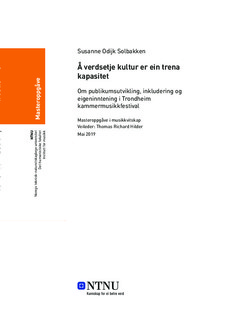| dc.contributor.advisor | Hilder, Thomas Richard | |
| dc.contributor.author | Solbakken, Susanne Odijk | |
| dc.date.accessioned | 2020-02-12T15:00:40Z | |
| dc.date.available | 2020-02-12T15:00:40Z | |
| dc.date.issued | 2019 | |
| dc.identifier.uri | http://hdl.handle.net/11250/2641403 | |
| dc.description.abstract | Denne masteroppgåva er ein studie av Trondheim kammermusikkfestival (Kamfest) og debattar om publikumsutvikling, inkludering og eigeninntening. Den vekelange festivalen Kamfest blir på ulike plan omtala som å lukkast med nå eit relativt ungt publikum, ved å blant anna kombinere høg kvalitet med ambisiøse og nyskapande tiltak. Hausten 2018 blei nye kulturpolitiske målsetjingar presenterte gjennom kulturmeldinga «Kulturens kraft». Her vektleggast blant anna eit auka fokus på eigeninntening i kulturinstitusjonar som Kamfest, i tillegg til målsetjingar om inkludering og demokratisering av kulturlivet. Denne oppgåva utforskar praktiske og ideologiske tendensar i denne nye kulturpolitikken gjennom undersøking av kulturinstitusjonen Kamfest.
Gjennom kvalitative metodar, og gjennom auga til både tilsette og publikum, undersøker eg kva visjonar og tiltak Kamfest har og gjer for å utvikle publikumsgrunnlaget sitt, og å skape gode og tillitsbaserte forhold mellom institusjonen og publikummet. Oppgåva er delt i to hovudkapittel. Første kapittel tek utgangspunkt i eit organisatorisk perspektiv ved å undersøke kva «publikumsutvikling» kan vere i Kamfest, og korleis denne publikumsutviklinga relaterer til breiare nasjonale diskusjonar om publikumsutvikling i dag, som inkludering og auka eigeninntening hos kulturinstitusjonar. Andre kapittel tek utgangspunkt i Kamfest- publikummet sine historier, og undersøker kva motivasjonar som ligg til grunn for deira deltaking på festivalen. Dette kapitlet belyser også korleis publikum sine historier og refleksjonar kan bidra til debattane om publikumsutvikling og inkludering i ein institusjon som Kamfest. Oppgåva avsluttast med eit diskusjonskapittel som trekk inn debattar om inkludering, kulturelt ansvar og kvalitetsrelatert definisjonsmakt i kultur. Samla sett påstår eg at Kamfest sine visjonar og tiltak berre delvis svarer til det publikumsutviklingsforskarar meiner er inkluderande publikumsutvikling. Sjølv om Kamfest i mange samanhengar vert oppfatta som nokså open og inkluderande blant både tilsette og publikummarar, eksisterer festivalen som del av eit ideologisk og praktisk system som ikkje er eit fullgodt utgangspunkt for ein inkluderande kulturpolitikk med gjennomslagskraft. I tillegg viser eg at det kulturpolitiske målet om auka eigeninntening kan bidra til å auke det økonomiske presset på kulturinstitusjonar, noko som kan resultere i tiltak som ikkje er effektive nok i arbeidet mot eit inkluderande kulturliv. Eg argumenterer difor for at dei to kulturpolitiske målsetjingane faktisk kan redusere, heller enn å styrke, kvarandre si gjennomslagskraft. | |
| dc.description.abstract | This master's thesis is a study of the Trondheim Chamber Music Festival (Kamfest) and debates concerning audience development, inclusion, and economic self-sufficiency. On several levels, the week-long festival Kamfest is viewed as successful in reaching a relatively young audience, for instance by combining high quality with ambitious and innovative activities. In the autumn of 2018, a new report from the Norwegian Ministry of Culture presented new directions for cultural funding and social aims. The report emphasizes economic self-sufficiency in institutions like Kamfest, as well as aims concerning social inclusion and democratization. This master's thesis explores the practical and ideological implications of cultural policy through examining the arts institution Kamfest.
Through qualitative research methods, and through the eyes of both employees and audience members, I examine Kamfest's visions and activities aimed at developing the festival's audience base, as well as building a trusting relationship between the festival and its audiences. This thesis is separated into two main chapters. In chapter one I examine the festival from an organizational view and ask what «audience development» might be for Kamfest. I also discuss how this audience development can relate to broader national discussions about audience development today, particularly concerning notions of social inclusion and an increased national emphasis that arts institutions should become more economically self-sufficient. The second chapter examines the experiences of the audience members of Kamfest as well as what motivates them to participate in the festival. In this second chapter I also discuss how the audience members' histories and reflections can contribute to the debates about audience development and inclusion in an institution like Kamfest. In the final discussion chapter, I draw on debates about inclusion, cultural responsibility, and the power of defining quality in the arts. Overall, I note that Kamfest's visions and activities only partially resonates with what audience development researchers claim as inclusive policies. Indeed, even though Kamfest may generally be viewed as an open and inclusive festival by employees and audience members, it still exists as part of an ideological and practical system that works against a more transformative inclusive cultural policy. Moreover, the aim in national cultural policies concerning economic self-sufficiency only contributes to the ongoing economic pressure in these institutions. This can result in actions which may not be efficient enough in the work towards inclusion in the arts. I therefore argue that the two mentioned aims in Norwegian cultural policies may hinder, rather than strengthen, each other's impact. | |
| dc.language | nno | |
| dc.publisher | NTNU | |
| dc.title | Å verdsetje kultur er ein trena kapasitet: om publikumsutvikling, inkludering og eigeninntening i Trondheim kammermusikkfestival | |
| dc.type | Master thesis | |
